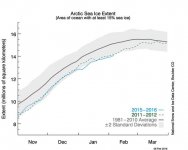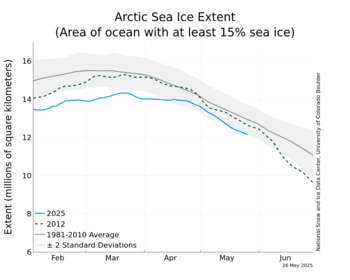BenBurch
Gatekeeper of The Left
As in prior years, this is a thread on Arctic Sea Ice for tracking sea ice over the course of the 2015 melt season.
This thread is approved by the moderator team for the limited purposes described, anything more than incidentally beyond that may be subject to moderator action.
Rule;
1. This is not an AGW thread.
2. This is about Sea Ice only.
3. You may speculate on the trajectory of Sea Ice melting in here.
4. You may post data from official sources and news articles from the science press in this thread.
5. No politics.
6. See rule 5.
Now, to start us off let us discuss the three measures of Sea Ice that are often misunderstood;
Sea Ice Extent; This is the total area of sea that is at least 15% ice-covered, so this can include a lot of open water, no open water, or anything in between. This is an easy measurement to make, and is useful for navigation; unless you are an icebreaker you do not want to sail into an area that is 15% ice. However, this is a very misleading measurement at times when you want to ascertain how much ice has melted.
Sea Ice Area; This is a better measurement in that it considers just the area taken up by ice. If 1 km2 is 20% ice-covered, that is .2 km2 area. So though this measurement CAN track Extent fairly closely, there is no guarantee it will, and it can diverge markedly under the right conditions. However, this tells you nothing about the thickness of the ice; It can be 1 cm thick, or 3 m thick and it is all the same in this measure, what counts is the area it covers. This measurement is a good way to judge the amount of sunlight rejected to space by white ice as opposed to dark water.
Sea Ice Volume; This is the actual physical volume of ice in polar waters. It is probably the best measure of how far the loss of polar ice has progressed.
Anomaly plots; When you compare the ice that on average would have been found on a particular date or range of dates, in any of the above measures, and subtract that from the number you measure, you get the first derivative of the that measure, and you can see how much ahead or behind the average you are. This is very useful as it is difficult to look at the sinusoidal annual cycle these numbers go through, and get a sense of comparison between two cycles. This removes the annual signal and just shows you how it had been modulated.
Ratios of multi-year ice to single-season ice at the*start of the melt season; Multi-year ice is generally thicker and more durable than single-year ice. New ice is more saline and so melts at a lower temperature than does multi-year ice. A season that begins with a large inventory of new ice is more prone to the effects of temperature anomalies and can under identical conditions produce a lower ice minimum.
This thread is approved by the moderator team for the limited purposes described, anything more than incidentally beyond that may be subject to moderator action.
Rule;
1. This is not an AGW thread.
2. This is about Sea Ice only.
3. You may speculate on the trajectory of Sea Ice melting in here.
4. You may post data from official sources and news articles from the science press in this thread.
5. No politics.
6. See rule 5.
Now, to start us off let us discuss the three measures of Sea Ice that are often misunderstood;
Sea Ice Extent; This is the total area of sea that is at least 15% ice-covered, so this can include a lot of open water, no open water, or anything in between. This is an easy measurement to make, and is useful for navigation; unless you are an icebreaker you do not want to sail into an area that is 15% ice. However, this is a very misleading measurement at times when you want to ascertain how much ice has melted.
Sea Ice Area; This is a better measurement in that it considers just the area taken up by ice. If 1 km2 is 20% ice-covered, that is .2 km2 area. So though this measurement CAN track Extent fairly closely, there is no guarantee it will, and it can diverge markedly under the right conditions. However, this tells you nothing about the thickness of the ice; It can be 1 cm thick, or 3 m thick and it is all the same in this measure, what counts is the area it covers. This measurement is a good way to judge the amount of sunlight rejected to space by white ice as opposed to dark water.
Sea Ice Volume; This is the actual physical volume of ice in polar waters. It is probably the best measure of how far the loss of polar ice has progressed.
Anomaly plots; When you compare the ice that on average would have been found on a particular date or range of dates, in any of the above measures, and subtract that from the number you measure, you get the first derivative of the that measure, and you can see how much ahead or behind the average you are. This is very useful as it is difficult to look at the sinusoidal annual cycle these numbers go through, and get a sense of comparison between two cycles. This removes the annual signal and just shows you how it had been modulated.
Ratios of multi-year ice to single-season ice at the*start of the melt season; Multi-year ice is generally thicker and more durable than single-year ice. New ice is more saline and so melts at a lower temperature than does multi-year ice. A season that begins with a large inventory of new ice is more prone to the effects of temperature anomalies and can under identical conditions produce a lower ice minimum.







